For sheer rugged beauty and a diversity of gorges, waterfalls, rockpools and canyons, few areas of Australia come near this region. International tourists are unanimous in naming their visit to Karijini National Park as a highlight of their trip to Australia.
Stretching for more than 400km through the Pilbara region of Western Australia, the Hamersley Ranges contain many spectacular gorges have been carved by the waters of the Fortescue and other rivers. Sheer walls of rock are layered in colours from red to green and blue to pink in the changing sunlight, forming wild and magnificent panoramas. The gorges are up to 100m deep, with the water flow at their bases sometimes only one metre wide. Others have wide crystal-clear pools reflecting the blue skies. Lush green vegetation thrives and the gorges are cool oases to swim in and escape the brilliant sunshine.
Karijini National Park protects the many different wildlife habitats, landscapes, plants and animals of the Ranges. Wildflowers vary with the seasons. In the cooler months the land is covered with yellow-flowering cassias and wattles, northern bluebells and purple mulla-mullas. After rain many plants bloom profusely. It is also home to a variety of birds, red kangaroos and euros, rock-wallabies, echidnas and several bat species. Geckos, goannas, dragons, legless lizards, pythons and other snakes are abundant. Huge termite mounds are a feature of the landscape and the rock piles of the rare pebble mound mouse may be found in spinifex country.
In the north of Karijini National Park, small creeks hidden in the rolling hillsides – dry for most of the year – suddenly plunge into sheer-sided chasms up to 100 metres deep. These are the Park’s famous gorges. They are spectacular but can be extremely dangerous. Further downstream, the gorges widen and their sides change from sheer cliffs to steep slopes of loose rock. Rocks exposed at the gorges originated as fine grained sediment which accumulated on an ancient sea floor 2,500 million years ago.
Every gorge is different, and each one is worth a visit but to explore these gorges in detail it helps be fit and prepared at times to submerge in near-freezing water, follow narrow paths and cling to rock ledges. If you’d rather play it safe, a visit to Oxer Lookout at the junction of Weano, Red, Hancock and Joffre Gorges is a must. Tiers of banded rock tower over a pool at the bottom of the gorge. Wow. It’s nearly impossible to describe how overpowering these gorges are, and the view from Oxer Lookout is quite staggering. Photos just don’t do it justice; staring down to the water some 100 metres below as it meanders past giant vertical, red cliff walls. Stunning stuff.
The Park is the traditional homeland of the Banyjima, Kurrama and Innawonga Aboriginal people. The Banyjima name for the Hamersley Range is Karijini. Evidence of their early occupation dates back more than 20,000 years. During that period, Aboriginal land management practices such as ‘fire stick farming’, resulting in a diversity of vegetation types and stages of succession, have helped determine the nature of the plants and animals found in the park today.
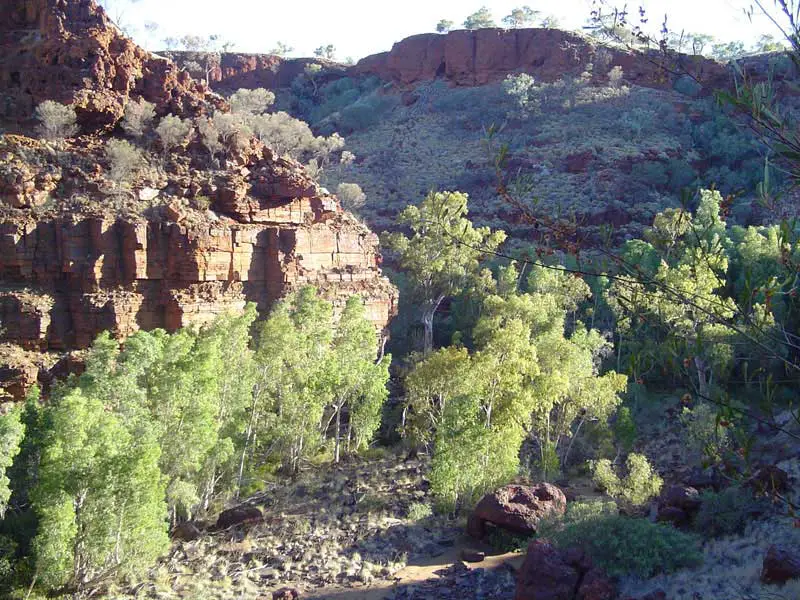
Dales Gorge
A crystal-clear stream, pools, waterfalls, and ferns contrast with the red, terraced cliffs weathered by centuries of exposure are highlights of this wonderful gorge. The occasional snappy gum can be seen perched on rocky ledges. A 4-kilometre return trail runs along the bottom of the gorge. Allow 3 hours for the return walk. After a loose, steep descent, another track leads to the hidden gardens of picturesque Circular Pool (800m return). This is an arduous walk, so you allow at least 2 hours return. A 1.2-kilometre return trail runs along the rim of Dales Gorge to Circular Pool Lookout.
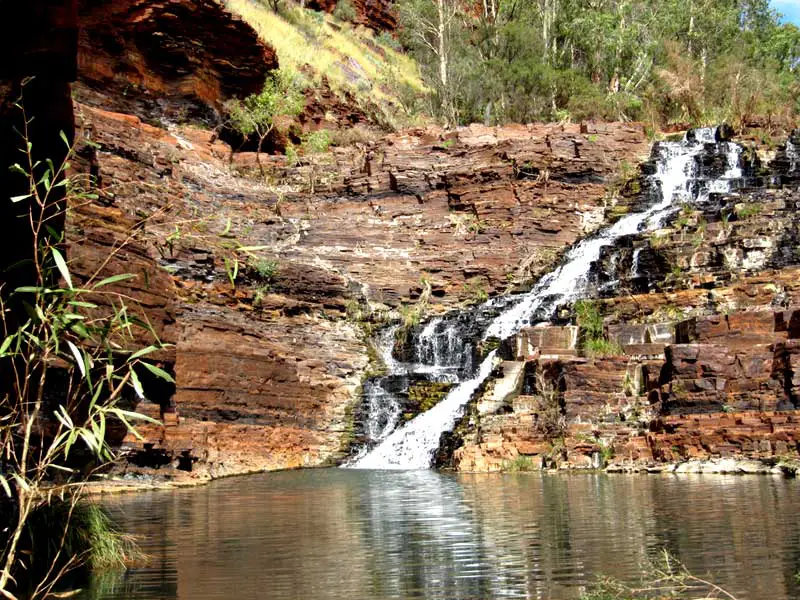
Fortescue Falls and Fern Pool
Fortescue Falls is a rare year-round waterfall in Dales Gorge in Karijini National Park. It tumbles some 20m over a series of red rock steps into a deep plunge pool at its base. This pool is one of the most popular swimming holes in Karijini National Park. Walk down through the changing vegetation of the iron-rich gorge walls to the waterfall. (800 metres, 2-hour return walk.)
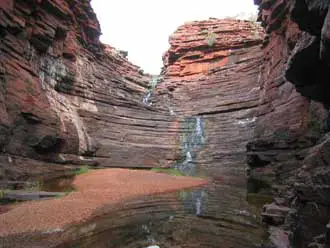
Joffre Gorge
The 100 metre high Joffre Falls is at the head of Joffre Gorge. A short track runs from the carpark to the lookout overlooking the falls, which are often dry, and the plunge pool at their base. (100 metres, 10 minutes return.) Follow the marked route into the bottom of this picturesque gorge to the first pool downstream of the waterfall. (3 kilometres, 3-hour return walk.) Peer deep into the Gorge from Joffre Lookout at the unusual curved wall which forms a natural amphitheatre. It’s particularly spectacular after a rain when a 100 metre waterfall cascades down its face.
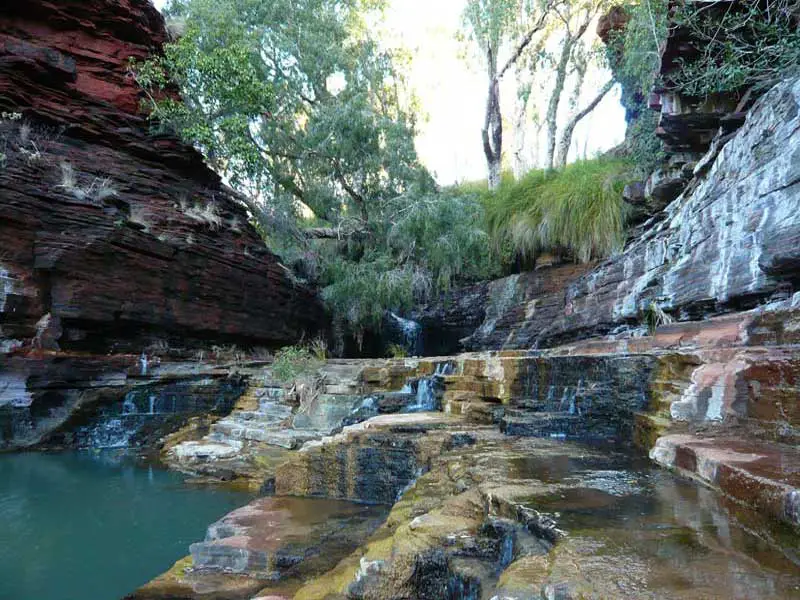
Kalamina Gorge
There is a 30-minute return walk into the gorge’s lush, shaded pool. Alternatively, walk within the gorge along a stream and small ponds (3 hours return). There is a small seasonal waterfall sitting at the head of Kalamina Gorge. The falls itself is a 5-minute walk from the car park.
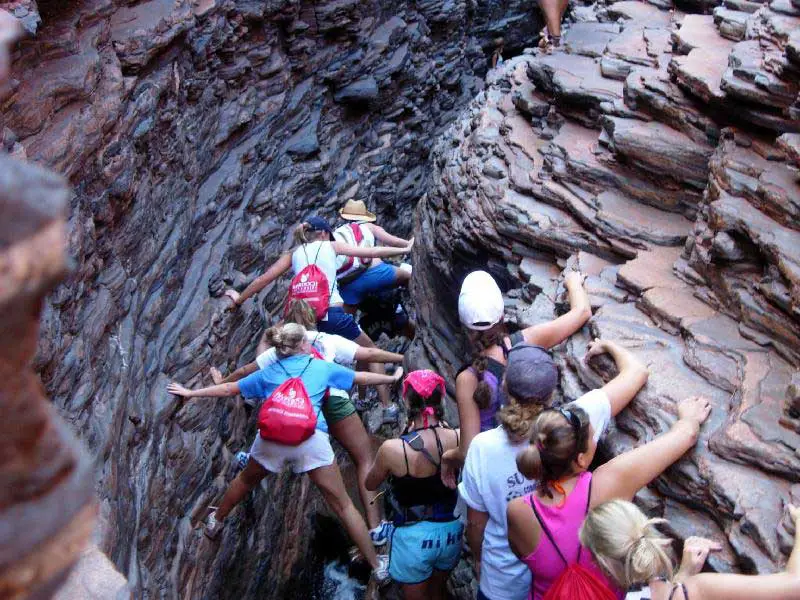
Kermits Pool Spider Walk
Of the many adrenalin adventures awaiting you at Karijini National Park in the State’s north west, The Spider Walk is one of the most challenging. This entails navigating your way through a very narrow gorge, approx one metre wide, with hands and feet on either side of the gorge walls as water flows underneath, very cool indeed! The reward at the end is a swim at Kermits Pool. Walk on a little a little further to the gorge opens out again – is simply breathtaking.
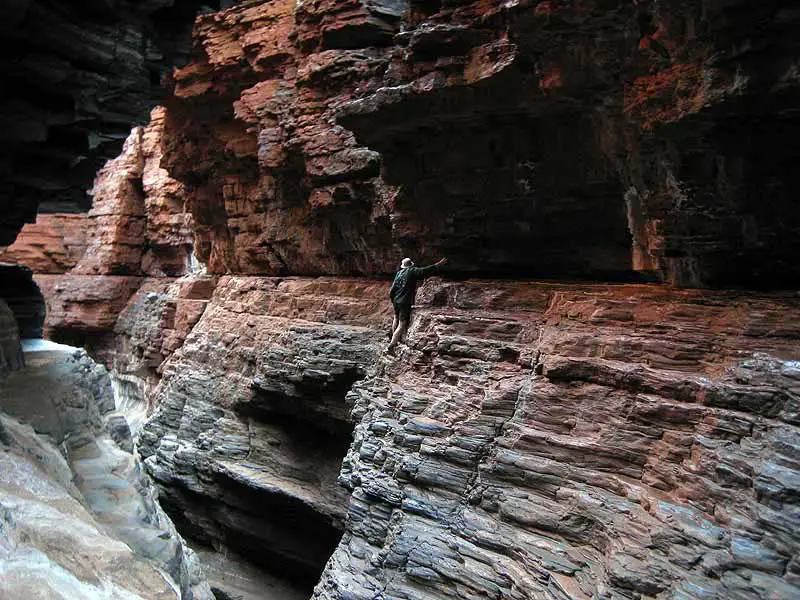
Hancock Gorge
ourney to the ‘centre of the Earth’ down this steep, narrow gorge. After climbing down a ladder you wander into the gorge which narrows into a huge chamber and an attractive setting of small rock pools and marbled walls. Feel the highly polished rock on the way down to Kermit’s Pool. Simply stunning, but best appreciated with a guide. (1.5 kilometres, 3-hour return walk.)
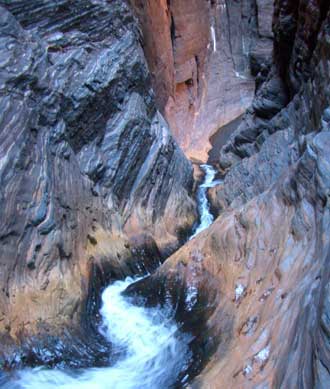
Hancock Gorge Chute
This is one of a number of narrow rock chutes in the gorges of Karijini National Park, however it is one of the few that is considered safe enough to traverse. The Chute drops about 35 metres down through some of the oldest rocks in the world, cascading into Regans Pool. Guided tours use a safety line to provide each participant with cowtails to secure themselves as they traverse about 20 metres above the pool. Care is needed here since the much-used footholds can be wet and slippery. Regans Pool is named after a volunteer rescue team member, Jim Regan, who was swept to his death in the Chute by a flash flood that occurred while he was participating in a rescue in Hancock Gorge.
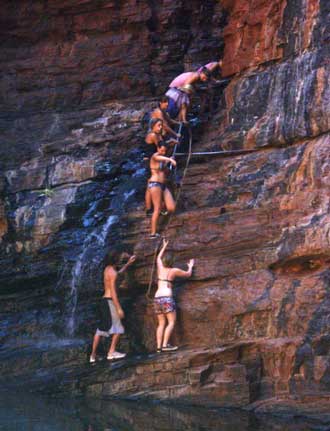
Handrail Pool
Weano Gorge is one of the three gorges which meet below the Junction Pool lookout. A short walk down steps and along the floor of Weano Gorge brings you to the stunning Handrail Falls and Pool, which is great for swimming.
Where is it?
339 km east of Perth in the Shire of Kondinin
The Best Time to Visit
Being situated just north of the Tropic of Capricorn, the climate here can best be described as tropical semi-desert. A highly variable, mainly summer rainfall of 250-350 mm, often associated with thunderstorms and cyclones, is accompanied by temperatures frequently topping 40 degrees Celsius. Winter days are warm and clear, but nights are cold and sometimes frosty. The ideal times to visit the park is between July and October.
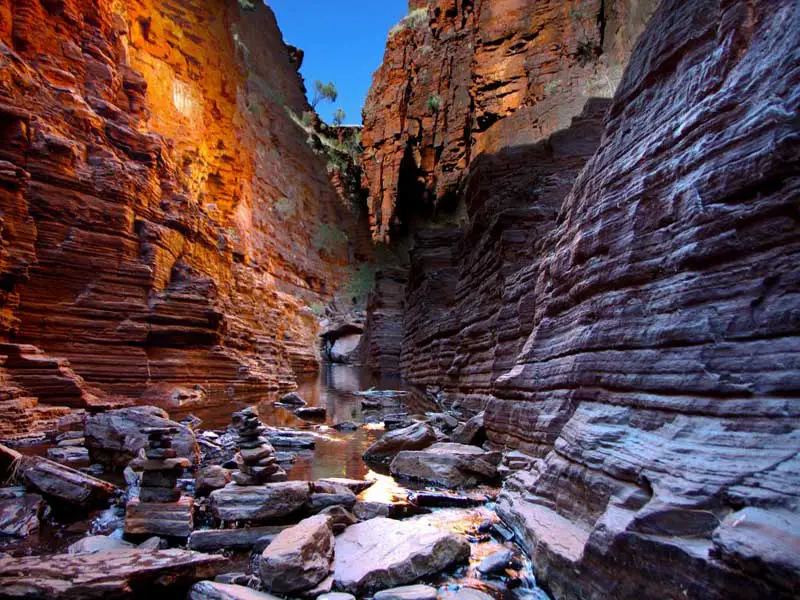
Red Gorge and Knox Gorge
Whether you’re above the gorge peering down or deep within it looking up, both these gorges provide a dramatic insight into the forces of nature which have shaped the earth. Within the gorges flow streams of crystal clear water and sand bars, warmed only by the midday sun. Red Gorge is one of the deepest gorges in the park, there are said to be parts of this gorge which never see sunshine. Access into this gorge is via Knox, Joffre or Hancock Gorges. Rangers must be notified before entering it.
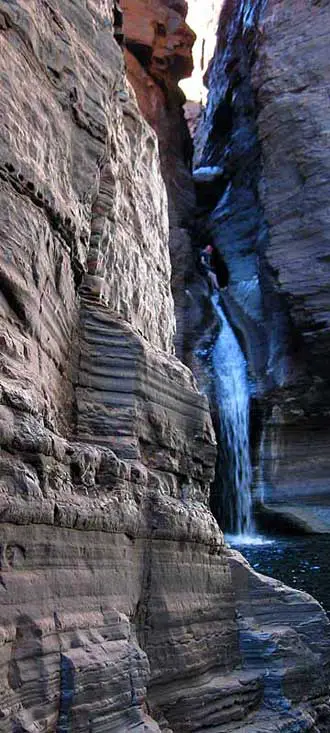
Knox Gorge Slide
One of the most challenging ways to get from Knox Gorge to Red Gorge is to use the Knox Gorge Slide, which is in fact a waterfall. It drops around 8 metre through a rock chute down which visitors can slide before being launched into a free-fall for another 4 metres into a deep, cliff-ringed pool. Over the years many visitors get temped to try it, but once you go down Knox slide (unless you bring proper climbing equipment) then there is no way back up. The next waterfall does not have a deep pool to jump into. Many people have been hurt attempting this over the years, so it is best left to the professionals.
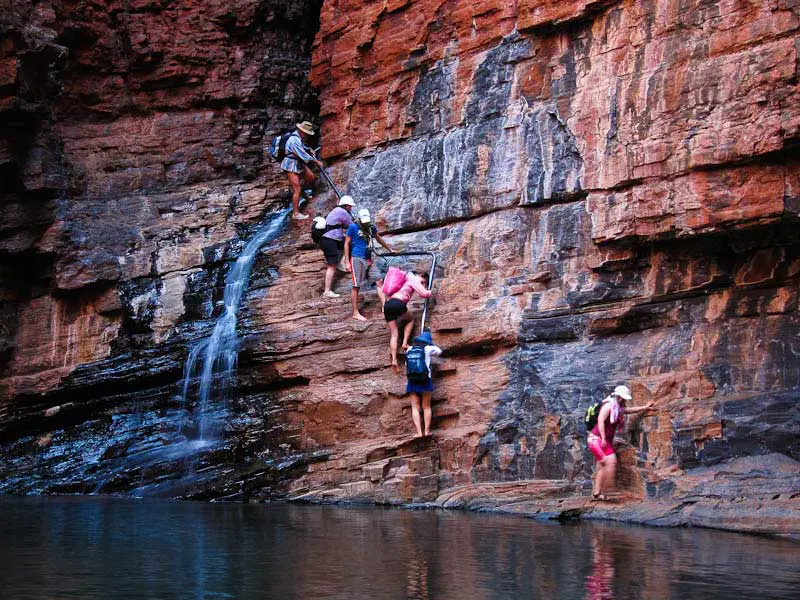
Weano Gorge
This picturesque gorge is possibly the best introduction to the walks of Karijini. It has a little bit of everything and it’s not too difficult. You have a relatively easy walk down steps to the base of the gorge and then a short meander between the layered rock walls and paperbark pools to Handrail Pool which is great for swimming. For the intrepid explorer, the adventure continues beyond the pool, though particular care needs to be taken. (300m return).
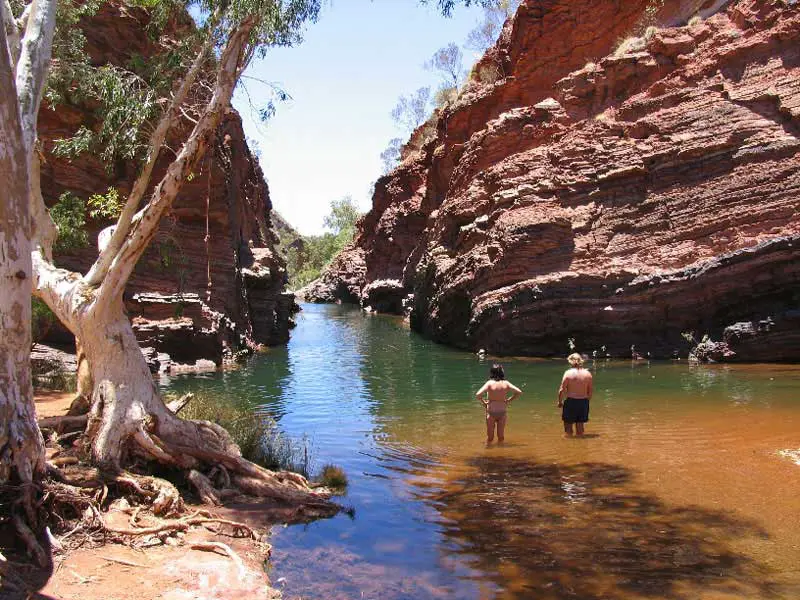
Hamersley Gorge
Quite different from the other gorges in this National Park, Hamersley Gorge features a dramatic wave of tectonic rock which forms a spectacular, angular backdrop to a pleasant swimming hole and natural spa.
Cathedral Gorge
Situated approximately 12 kilometres west north west of Newman, an iron ore mining town on the Great Northern Highway. Although not large, its spectacular layers of iron banded shale and rugged, craggy rock formations that are forever changing colour, make a beautiful backdrop for the leafy foliage of the trees and shrubs in that area.
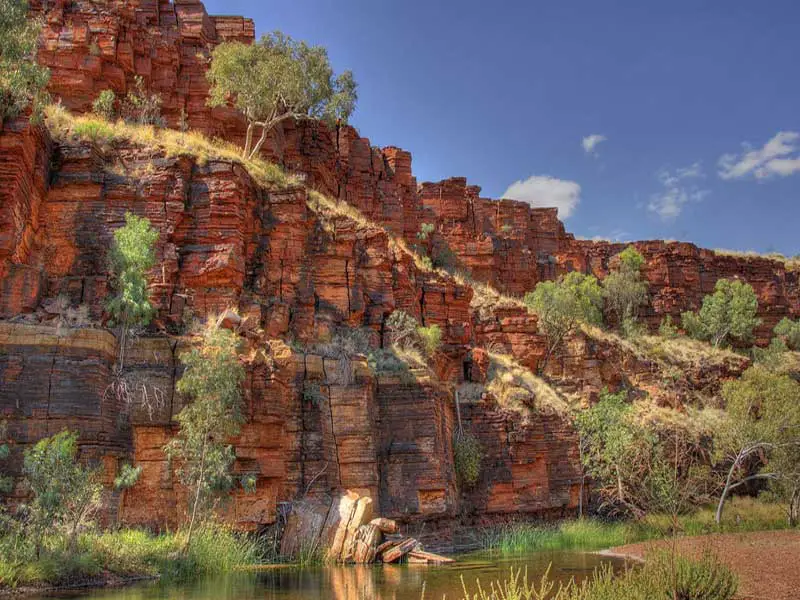
Yampire Gorge
A gorge you can drive through, passing by the white/grey trunks of the ghost gums which stand out majestically into the night like sentinels keeping guard. A great place to experience the ‘Sound of Silence’. The first mining of blue asbestos in the Hamersley Ranges took place here in the 1930s. Driving through the gorge you can see blue flecks of asbestos within the rock. Remember that the dust from asbestos is deadly so do not disturb these rocks and avoid breathing in the dust.
Camping is not permitted in Wittenoom Gorge or Yampire Gorge and authorities recommend visits to contaminated areas should be avoided, but, if undertaken, should be of short duration, preferably less than one day.
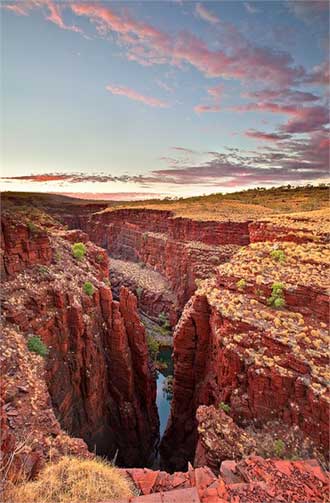
Oxer Lookout
Possibly the most stunning lookout in Australia, Oxer Lookout is a natural rock platform perched on the cliff top high above the junction of Joffre, Hancock, Red and Weano Gorges. This lookout offers some of the most breathtaking views in the park down each gorge, and illustrates how different they are. There are a few walks from here, with the more difficult trek leading to Hancock Gorge and the slightly easier walk leading to Weano Gorge.
The lookout is named after Dr Gordon Oxer, who worked at the blue asbestos mining town of Wittenoom during the early 1960s. He was the sole private medical practitioner in an area of thousands of square kilometres. Dr Oxer loved the Hamersley Ranges and spent much of his spare time exploring them and taking visitors on walks through the gorges. Many of the tracks through the gorges were established by him.
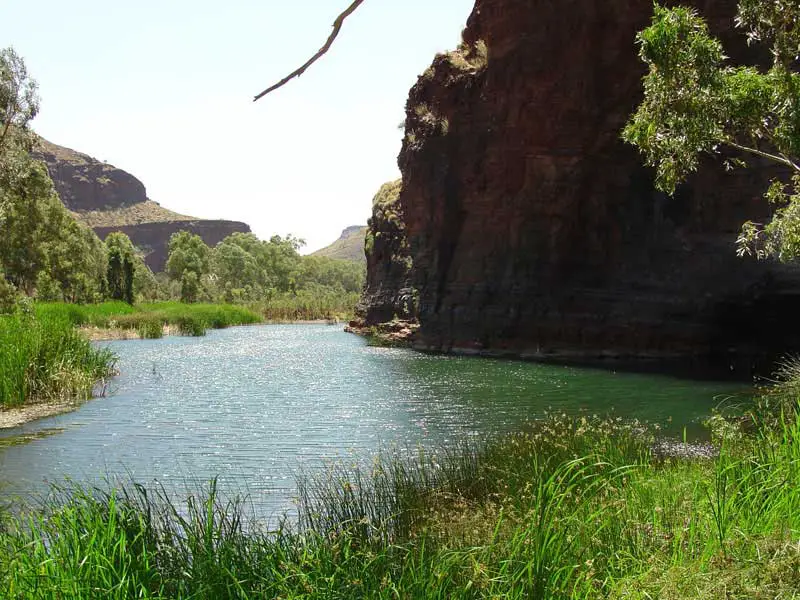
Wittenoom Gorge
This gorge helped put the Hamersely Ranges on the map. Its Blue Asbestos Mine, once owned by Hancock and Wright and operated by CSR, has a a strong association with the town of Wittenoom, created to house the asbestos mine workers. The mine has been closed since 1966 and Wittenoom is now closed and a ghost town, because of the health dangers of the blue asbestos dust found in abandance here. Camping is not permitted in Wittenoom Gorge or Yampire Gorge.
The magnificent gorge is still there to drive up and enjoy, however health authorities don’t advise passage through it. If you do wish to go there, as a safety precaution, it is advisable to keep windows of your vehicle closed when passing through the gorge. The mine buildings are no longer there, but the tailings remain. The gorge is very pretty, and a feature is the Town Pool, so named because it doubled as the town’s swimming pool.
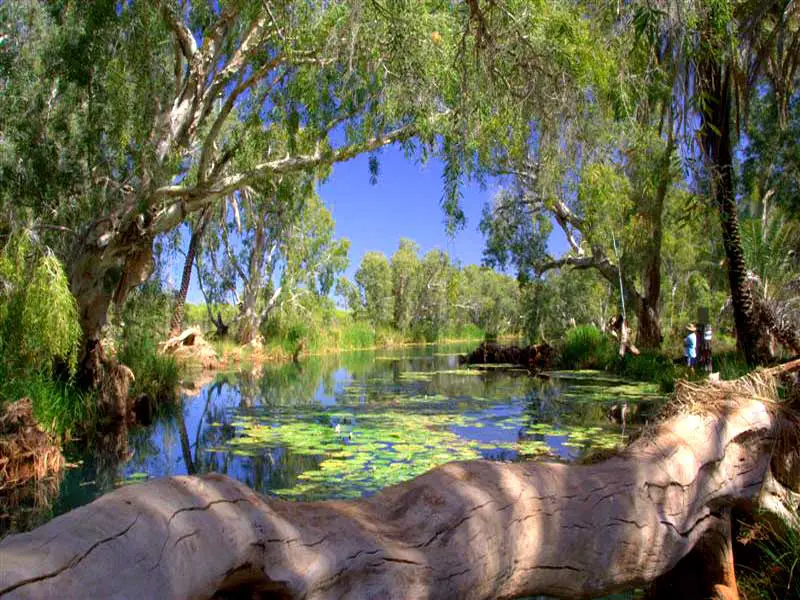
Millstream
An enchanting tropical oasis amongst the red dust of the Pilbara, where the water table reaches the surface. Thousands of birds flock to this delightful spot, where ferns, palms and rushes grow in abundance. Clear, soft water from an underground aquifer creates a lush freshwater swimming spot at Chinderwarriner Pool, with over 36 million litres of water produced daily. The adjacent Chichester Ranges, also on the road between the Hamersley Ranges and the coast, contain sediment-capped basalt ranges. It has rolling hills, hummocks of spinifex, white barked snappy gums on the uplands, and pale coolabahs along the water course.
Canyoning Guide
If you intend going canyoning in Karajini National Park other than with a guided tour group, we recommend you download and follow the advice in the following documents:
Design by W3Layouts | Content © 2013 Phoenix Group Co. | Sales: phone 1300 753 517, email: [email protected]

